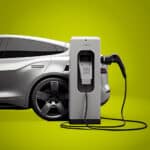This case study originally appeared in our 2023 Report: Your Influence Matters: Peer Influence and EV Adoption, which shows how an individual’s personal influence really matters when it comes to encouraging clean energy behaviors like driving electric.
In 2013, Chuck and Beth were in the market for a new car and were contemplating hybrid technology. Their neighbors, Paul and Claire, who drove a Toyota Prius and a Chevrolet Volt, suggested that they take the two cars for a test drive. That’s all it took – Chuck and Beth wound up purchasing a plug-in hybrid Volt, which they loved and owned for about four years before buying a fully electric Chevrolet Bolt in 2017. Paul and Claire were a trusted source of information for the Hubers, and Beth also had access to EV charging at her place of work.
Beth was the main driver of their first EV, the Volt. She had the longest commute (around 52 miles round-trip), and was able to charge the car for free during the work day. The Volt was mostly a commuter vehicle, and although it had a 45-mile electric range with an eight-gallon reserve tank for gas, the Hubers almost never needed to gas it up. “We loved seeing how far we could get without having to put a tank of gas in it – at one point we traveled 8,500 miles before we had to refill.
In 2017, the Hubers added the all-electric Chevy Bolt to their life because Chuck was impressed with the vehicle’s range (236 miles on a full charge). It was a smooth transition from a plug-in hybrid to a full EV. By this time, Chuck’s workplace had also added charging stations. Although the chargers weren’t free (he had to pay 10 cents per kilowatt-hour), the Bolt’s range, plus home charging, meant he didn’t need to use them often. Chuck learned which of his colleagues also drove EVs, and they quickly established a work email group to notify one another when they needed to charge their cars or when a charger was free.
“There is no question that [our neighbors] definitely put us on the path to full electrification by introducing us to hybrid vehicles.” – The Hubers
A number of factors motivated the Hubers to drive electric. Initially, it was their neighbors and the fluctuating price of gas, but Chuck and Beth also wanted to reduce tailpipe emissions. Free charging at Beth’s workplace was another key incentive. “We bought the smallest and most fuel-efficient vehicle that would meet our needs.” The Hubers have been tremendously pleased with how low-maintenance their Bolt is. “It’s been a great vehicle, and at 74,000 miles, we are not ready to part with it. It’s our default vehicle – we drive it as much as possible.”
Chuck and Beth have driven their Volt (and now Bolt) to family get-togethers, plugging in along the way and answering questions about the vehicles. In the last few years, Beth’s nephew and brother-in-law have both become EV owners. Chuck also participates in Drive Electric Events, sharing his EV experience with others, and has presented to students in Paul’s class on environmental sustainability. Chuck says he’s most often asked about EV range – a question he’s happy to answer, based on his own driving experience.
















